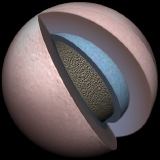 |
|
|
Seen
from the distance of Pluto, the Sun is a bright star.
|
|
| THE EVOLUTION OF PLUTO | |
| Pluto is tiny. Just 2,445 kilometres across, it is the smallest of the nine planets. It is half the size of Mercury and smaller than each of the four Galilean satellites. | |
| Before the discovery of Pluto's moon Charon, it was thought possible that Pluto had once been a satellite of Neptune which had escaped. As a satellite of Neptune, its orbit had been disturbed by Neptune's Triton, sending it off course and into its present path about the Sun. The existence of Charon though invalidated the idea. It is now thought that Pluto and Charon formed independently of the other planets. | |
| Many improvements in our understanding of Pluto resulted from the discovery and observation of Charon. It has enabled a more accurate calculation of Pluto's mass and density. Both bodies have densities of about 2000 kg m-3 . From this the bulk of both Pluto and Charon are inferred to consist mostly of silicate rock and other organic compounds (containing carbon) like methane (CH4). Though icy, Pluto is deficient in water ice. Because it is quite small, it would have lost heat quite quickly compared to the other terrestrial planets, there is some evidence that Pluto did differentiate fully. Early in its history some heat would have been available from larger impacts as well as the decay of radioactive materials. | |
| Pluto is thought to comprise a large rocky silicate core with a radius of 855 kilometres (70% of the total) surrounded by an ice mantle 367 kilometres thick (30%). The mantle is overlain by a thin methane crust. The existence of icy material on the surface suggests that the meteorites forming these planets were more like comets, with a covering of dirty ice, rather than the familiar rocky kind. | |
 Cross-section through Pluto. |
|
|
|
|